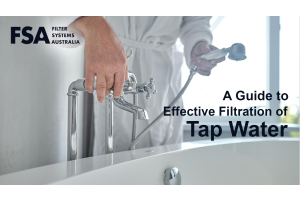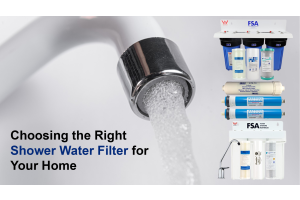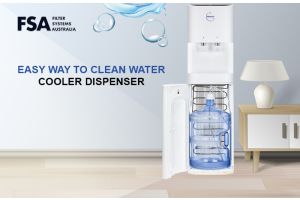
Water is an essential part of human lives. That is why the UN recognizes that access to clean water is a fundamental right. The demand for everyone to have clean water is a part of the UN Sustainable Development Goals to create a better world for everyone.
Every person should have at minimum 20-50 Litres of clean, safe water daily to cook, drink and bathe in. We're far from this objective, and it'll require a massive effort from all of us to bring this goal to fruition.
The world is facing an increasing water shortage, and half the world's population is expected to be living in areas with water shortages in 2025. Currently, more than 2.5 billion people cannot access safe, pure drinking water that can be accessed in a round travel time of about 30 minutes per the World Health Organization (WHO).
The causes of water shortages are complicated. It is partly because of population growth and the loss of groundwater resources that 30% of the freshwater on earth is found in deep aquifers and is being extracted at dangerously excessive levels.
The infrastructure for water in many areas is in decline, and millions of gallons of clean drinking water go unaccounted for each year. The water is used in agriculture, irrigation, energy generation, and other water-intensive industries.
According to WHO, lack of sanitation and water quality affects 780 million people who reside in economically disadvantaged areas. WHO estimates that contaminated drinking water is responsible for 502,000 deaths each year.
All of this can be prevented with access to clean water. In recent times, various new water treatment technologies have come up to supply water to those who need it the most.
Solar Powered Water Filtration
In many parts of the world, the issue isn't because there's insufficient water but rather because water sources are polluted. In developing countries, around 80 percent of sewage is discharged into waterways without any treatment. That's why Innovative Water Technologies developed water filtering systems like the SunSpring Hybrid, a self-contained portable wind and solar-powered system that supplies 20,000 litres of clean water every day for 10 years or more.
Fog Catchers
In certain areas, the groundwater resources have been depleted, and entire communities and villages are suffering from an acute water shortage, such as those in the Sidi Ifni region of Morocco. However, what this region does have is a large amount of fog. This is why Dar Si Hmad, a non-profit, has put fog collectors along the mountain slopes of Mount Boutmezguida in what is the biggest fog harvesting project worldwide. More than 6,300 litres can be harvested each day.
The process isn't too complicated; the mist is captured when it travels through the web of huge vertical nets and then flows into a collection system, where it is treated and blended with groundwater. The water is then piped to five villages, providing safe and clean water to 400 people. The technology isn't new; recent advances have made it significantly more efficient. Fog-catching systems are also used in Chile, Peru, South Africa, Ghana, Eritrea, and California.
Desalination Seawater Sea
Israel is a country that is comprised of 50% desert and has been experiencing drought-like conditions for several years. It's not surprising that the process of desalination - which removes minerals and salts from seawater - was developed in this region. This first facility was constructed in the 1960s, and now 60% of the nation's domestic water comes from desalination from 5 large and 34 small plants. Three of the plants are controlled through Israel Desalination Engineering (IDE) technologies, a global pioneer in the design and maintenance of desalination plants that include 400 plants in 40 countries such as China, India and the US.
Did you know that there is even a Reverse Osmosis Desalination Plant operated by SEQ Water in Bilinga (right next to the Airport) on the Gold Coast in Queensland, Australia!
The Drinkable Book
The non-profit Water is Life in collaboration with researchers from Carnegie Melton, created an education and water filtration tool in the form of a drinkable book. Each page is filled with the basics of water and sanitation guidelines printed on coffee filter paper that is scientifically designed and can be utilised to purify water and remove 99.9% of the bacteria. Every book - distributed in Ghana, Kenya, Ethiopia, and Haiti will supply a person with clean water for four years.
Water from Air - Zero Mass Water
Zero Mass Water start-up uses solar power to generate enough clean drinking water for two to three people, or approximately 10 litres per day. The technology, dubbed Source Hydropanel, runs on a pretty simple premise. Solar energy is used to heat the sponge-like material to create condensation, which is then gathered in the 30-litre reservoir. The water is then filtered, and then minerals are added to enhance the water's flavour. Zero Mass is partnering with organisations worldwide to supply safe and clean drinking water.
The LifeStraw
The portable drinking straw was created by Vestergaard - the world's leading company developing innovative solutions that create sustainability and a healthier world. The straw filters unclean, unsafe water, making it acceptable to drink. The straw cleanses at least 1,000 litres of water. It eliminates 99.9 %of the bacteria and parasites with the unique filtering system. There are also high-capacity water purifiers available for emergency preparedness and response teams. Now available in steel rather than plastic.
Wrapping Up
These visionary water treatment solutions can help us achieve a better future for all. At Filter System Australia, we offer a variety of both industrial and home water filter solutions that will fulfil all your clean water needs.



